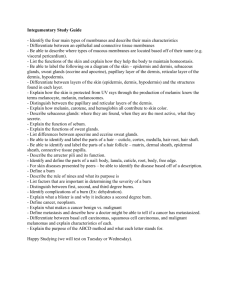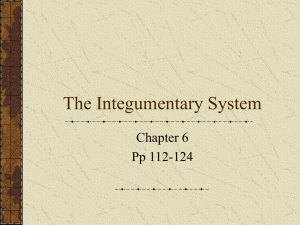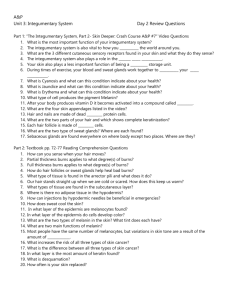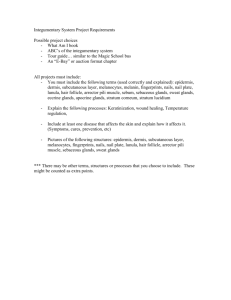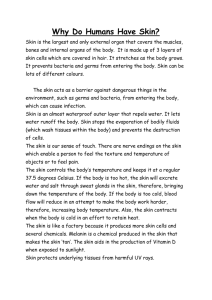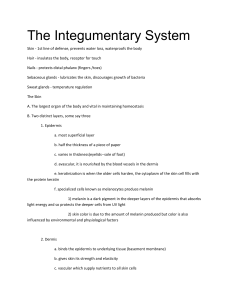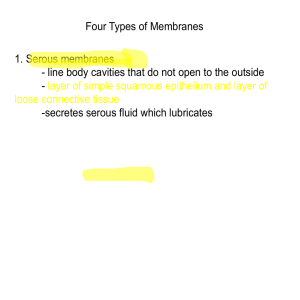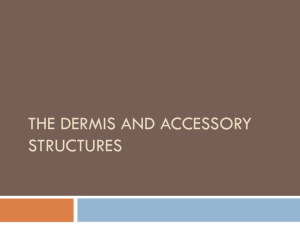The Integumentary System
advertisement
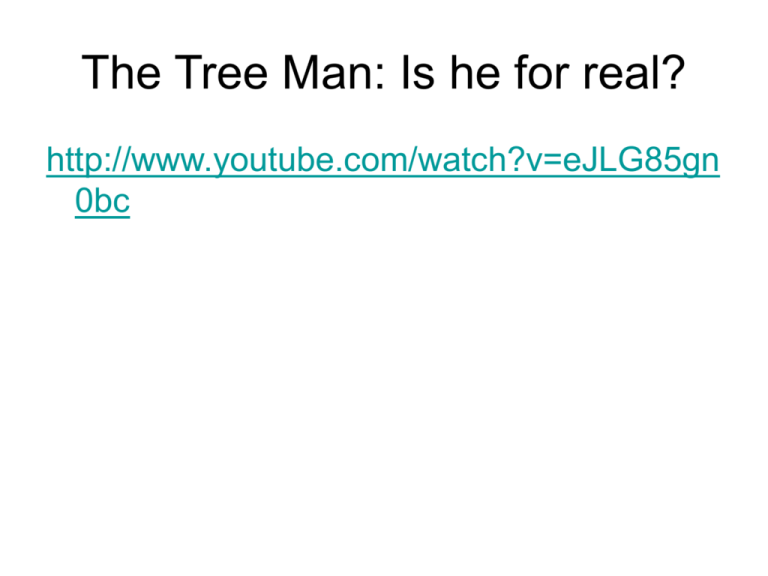
The Tree Man: Is he for real? http://www.youtube.com/watch?v=eJLG85gn 0bc The Tree Man… • What is the tree man suffering from? • Is there a cure? • What system is being affected in this story? The Integumentary System Your job… • Draw a diagram of skin on the whiteboard and label the parts • In a few minutes we will go over the diagram. What is Skin? Skin Cells • mesodermal cells – Middle layer of epidermal development in fetus and some of it eventually becomes skin • Melanocytes – Pigment cells – Contain melanin Epidermis Layer Dermis Layer • What can you see from this tissue sample? Dermis Layer • second of the three major layers of skin. • The dermis varies in thickness depending on the location of the skin. It is .3 mm on the eyelid and 3.0 mm on the back • composed of three types of tissue that are present throughout - not in layers – collagen, elastic tissue, and reticular fibers Two layers primarily… • upper, papillary layer, contains a thin arrangement of collagen fibers • lower, reticular layer, is thicker and made of thick collagen fibers that are arranged parallel to the surface of the skin. contains many specialized cells and structures • hair follicles • Arrector pili muscles • Sebaceous (oil) glands and apocrine (scent) glands associated w. hair folicle • eccrine (sweat) glands • Blood vessels and nerves • specialized nerve cells called Meissner's and Vater-Pacini corpuscles that transmit the sensations of touch and pressure Skin Glands • Eccrine glands secrete sweat, a mixture of 99 percent water and 1 percent salts and fats. – In warm conditions with low humidity, perspiration (secretion of sweat) and evaporation cool the body. Skin Glands • The apocrine glands secretions contain pheromones, substances that enable olfactory (sense of smell) communication with other members of the species. – armpits, areolae of nipples, and the genital region • Sebaceous glands (oil glands) are all over the body except on the palms of hands and soles of feet. – Sebum keeps hair moist and prevents skin from drying. Hair • cornified threads of cells that develop from the epidermis • has a medulla, cortex, and cuticle • hair root in a hair follicle is embedded beneath the skin • hair shaft protrudes from the skin • sheds and is replaced constantly during growth and rest phases • eyebrows keep sweat from running into the eyes, nose and ear hairs filter dust from the air, and scalp hairs protect against abrasion and overexposure to sun rays. Nails • hard plates of keratinized cells are at the ends of fingers and toes • appear pink because their translucency reveals the vascular tissue beneath • aid in grasping objects, scratching, and protecting fingers and toes Nails Continued… • components of the nail are the lunula, body, root, and free edge • lunula is the white halfmoon shaped part at the nail base • body and free edge region that overhangs the end of the finger or toe are visible • thick layer of epithelial skin called the nail bed • root is hidden under skin folds Skin color • results from the presence of melanin, carotene (yellow to orange pigment), and underlying blood reflected through skin. • Melanin keeps excessive ultraviolet rays from burning the skin • Variety of skin color is caused mainly by the number and distribution of melanocytes • different skin colors among individuals and races show different kinds and amounts of melanin production by melanocytes • Asian peoples produce a greater amount of carotene in the stratum corneum, producing a yellowish tinge • Albinism is a condition where skin does not produce melanin. Hypodermis, aka… The hypodermis (subcutaneous layer) lies beneath the dermis. Loose connective tissue such as adipose tissue (fat) insulates the body, conserving heat. It also contains blood vessels, lymph vessels, and the bases of hair follicles and sweat glands. Tissue Repair and wound healing Tissue Repair Wound Healing • 2 ways: – Regeneration: replacement of destroyed tissue by cells – Fibrous: “scar tissue” • Depends on type of tissue damaged & severity • wound healing animation • Granulation tissue • Good regeneration: – Skin, bone • Poor regeneration: – Cardiac & nervous tissue NEOPLASMS- Cancerous or Benign • Cell divides rapidly (cancerous or benign) Hyperplasia • Tissues enlarge because of a stimulus that irritates the cells Atrophy
